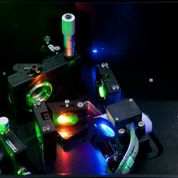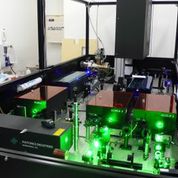GANIL
Integration of a resonant ionization laser ion source system into the existing off line test bench of the SPIRAL2 TISS
Trainee: Jose Luis Henares
Supervisor: Nathalie Lecesne
Jose Luis Henares will focus on the development of the new laser ion source for the SPIRAL2 facility by optimizing the resonant laser ionization of selected elements of interest while reducing, if possible, the contamination by unwanted species. For that purpose he will develop resonant laser ionization schemes and study the properties of different hot cavities. These results will be used in the SPIRAL2 ion source prototype conception and development for the integration of a resonant ionization laser ion source system into the existing off line test bench of the SPIRAL2 TISS. He will also participate in the off-line experiments to study RILIS for complete characterization of the system regarding ionization efficiency, selectivity, ion beam emittance and long term operation.

The Target and Ion Source System (TISS) has to be carefully designed, fulfilling the following requirements: high radiation hardness, long term reliability of no less than 3 months, and high efficiency. The source has to be optimized to maximize the photo ionization efficiency of the element of interest while minimizing the surface ionization of unwanted elements present in the production target. Therefore different materials, ionizer forms, diameters and lengths, as well as field geometries will be studied.
Study of resonant laser ionization in the REGLIS low energy branch of the S3 spectrometer at SPIRAL2-GANIL
Trainee: Lara Hijazi
Supervisor: Nathalie Lecesne
The REGLIS (Rare Elements in-Gas Laser Ion Source and Spectroscopy) device will be installed at the Equipex project S3 (Super Separator Spectrometer), currently under construction as part of the SPIRAL2 facility at the GANIL (Grand Accélérateur National d’Ions Lourds) laboratory in Caen, France. REGLIS will be a source for the production of new and pure radioactive ion beams at low energy as well as a spectroscopic tool to measure nuclear hyperfine interactions. It consists of a gas cell in which the heavy ion beam coming from the S3 spectrometer will be stopped and neutralized, coupled to a laser system that assures a selective re-ionization of the atoms of interest. Owing to the unique combination of such device with radioactive heavy ion beams from S3, a new area of unknown isotopes at unusual isospin will become accessible. This device has been very recently selected by the French National Agency for the funding of the gas cell set up and will benefit from the international expertise of the group from KU Leuven, who obtained an ERC grant for their contribution to the project. REGLIS will provide the Equipex project S3 with a unique tool and will become a world leading facility in laser spectroscopy.
The purpose of the early stage position is to study the possibility to integrate an existing all solid state Titanium:Sapphire laser system in the REGLIS set up and to improve and develop the laser system in order to fulfil the requirements for the spectroscopic studies at REGLIS. The solid state laser system used is developed in collaboration with the University of Mainz (Germany), the TRIUMF laboratory (Canada) and the ISOLDE group in the CERN facility. Lara Hijazi will design, build and test a tracking system for the scan of frequency doubled light by synchronizing a remote controlled grating laser with a motorized SHG crystal. The feasibility of using difference frequency generation to extend the range of the existing Titanium:Sapphire cavities will also be investigate. This is very challenging but would considerably increase the possibilities of such a set-up.
Lara will also work off-line to develop and evaluate ionization schemes for elements requested at the low energy branch of S3.
This project takes place within a large international collaboration (KU Leuven, Mainz University, TRIUMF laboratory, ISOLDE at CERN) and Lara Hijazi will have the opportunity to contribute to scientific experiments in these laboratories and also to benefit from the expertise of the partners in LA³NET.
Video:
Scientist in Charge:
Images courtesy of GANIL
